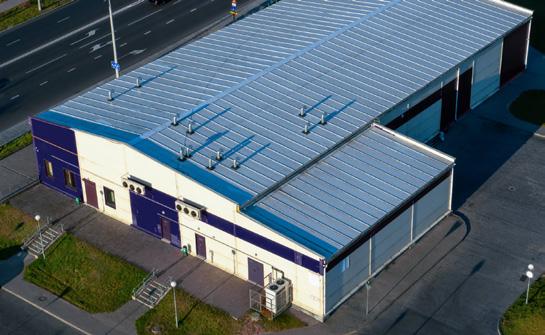
3 minute read
Indian In-city Warehousing Emerging Trends in
India has experienced a significant shift towards online retail. As a result, in-city warehousing has become an essential component of infrastructure development in urban areas. Large national developers are now entering the in-city warehousing space and are expected to use their existing residential and commercial real estate to build these warehouses. This trend is expected to continue as more developers recognize the potential use cases and benefits of in-city warehousing. ‘In-city Warehousing: The Emerging Backbone for Quick Commerce,’ a knowledge paper by A&M India Managing Directors
Manish Saigal and Sudeep Mehrotra and Senior Director Abhishek Kochar, examines the adoption and trends of in-city warehousing in India, as well as the challenges and solutions associated with it. The note also draws on global in-city warehousing trends to provide insights and key considerations for developers.
Advertisement
THE significance of last mile delivery in the e-commerce industry cannot be overstated. Despite only contributing to 10-15% of the value chain's distance traveled, last-mile deliveries and reverse logistics account for nearly half of the delivery costs. The solution lies in improving urban logistics by analyzing distribution patterns based on town characteristics.
In-city warehouses and fulfillment centers need to be established closer to end customers to facilitate quick commerce and substitute front-end real estate. In-city warehousing plays a pivotal role in city development and infrastructure, including different models like dark stores, MFCs, mini warehouses, and ghost kitchens. By 2030, dark stores globally are expected to reach 45,000-50,000, primarily in Europe and the United States. Early adopters like Amazon and
Carrefour have already opened dark stores in the US and Europe. With 5055% of the global population residing in urban areas and the growing need for faster deliveries, in-city warehousing will rapidly expand. Therefore, prioritizing and investing in urban logistics and infrastructure is imperative to support e-commerce and in-city warehousing growth. Moreover, urbanization is expected to increase to 60-70% in the next 7-8 years, boosting the growth of urban logistics.
Potential Uses Of Incity Warehousing
In-city warehouses, including dark stores, micro fulfillment centers (MFCs), mini warehouses, and ghost kitchens, have various potential uses. Dark stores cater to e-commerce and quick commerce, with delivery times of 1030 minutes for e-grocery and one day for other categories. MFCs primarily serve FMCG companies and are used for consolidation and distribution to local stores and can also fulfill B2B orders and same-day delivery for D2C brands. Mini warehouses provide forward storage for apparel and retail stores within the city. Ghost kitchens partner with third-party aggregators to deliver food, with delivery times ranging from 20-40 minutes. Incity warehouses can have delivery radii from 1-3 km for dark stores to 20-40 km for MFCs and mini warehouses. The market size of in-city warehousing is expected to reach approximately 17 mn sqft by FY’26, up from approximately 8 mn sqft in FY’22.
Current Trends
Most in-city warehousing in India is found in repurposed commercial spaces like unused offices, supermarkets, restaurants, hotels, and parking lots.
A schematic representation of a value chain for a dark store:
Mini warehouses and micro fulfillment centers, which have lower specifications, are also likely to be built on repurposed land. However, with national developers entering the in-city warehousing space, it is expected that Grade A-equivalent warehouses will be built using existing residential and commercial real estate. By FY'26, this market is projected to grow to approximately 4 mn sqft, with the majority of Grade A product being consumed by dark stores built on non-repurposed land within 1-3 kms proximity of the customer.
The rise of micro fulfillment centers in India can be attributed to catering to the hyperlocal demand for unorganized retail, such as local kirana stores. These centers will have smaller delivery radii compared to their global counterparts, and ghost kitchens will also grow at a fast pace with delivery limited to 1-2 km.
In-city dark stores and fulfillment centers, which are currently set up on ground floors, may adopt multi-story structures to meet increasing demand in major urban centers. Rental costs range from INR60-85 per sqft and vary between cities. In-city warehouse rentals are higher than larger Grade A warehouses located on the outskirts with closer proximity to national highways.
Dark stores have become popular in the grocery sector, with 61% dedicated to grocery slot deliveries and 24% for grocery quick commerce. Milk and morning deliveries, D2C brands, E-pharmacy and online meat delivery make up the rest. As of 2021, the National Capital Region, Bengaluru, and Mumbai accounted for over 50% of dark store usage in India.
Challenges And Solutions
There are many challenges to the adoption of in-city warehousing, primary among them, poor location selection. An ideal location should have a mapped route to all key demand centers within the delivery radius to avoid traffic congestion. Key factors to consider include location demand footprint, expected demand evolution, population density, and demographics. As national developers enter this space, larger custom-built spaces with adequate loading bays may be required for better operational efficiency. Stock-keeping unit planning and demand analytics are critical for enabling approximately 1,500-2,000 SKUs, minimizing stockout situations, and periodic SKU rationalization. Delivery optimization is crucial and should be driven by an initial location analysis, assessment of trade-offs, and real-time demand pattern analysis. Although every industry encounters obstacles, the field of urban warehousing is poised for robust growth going ahead.





